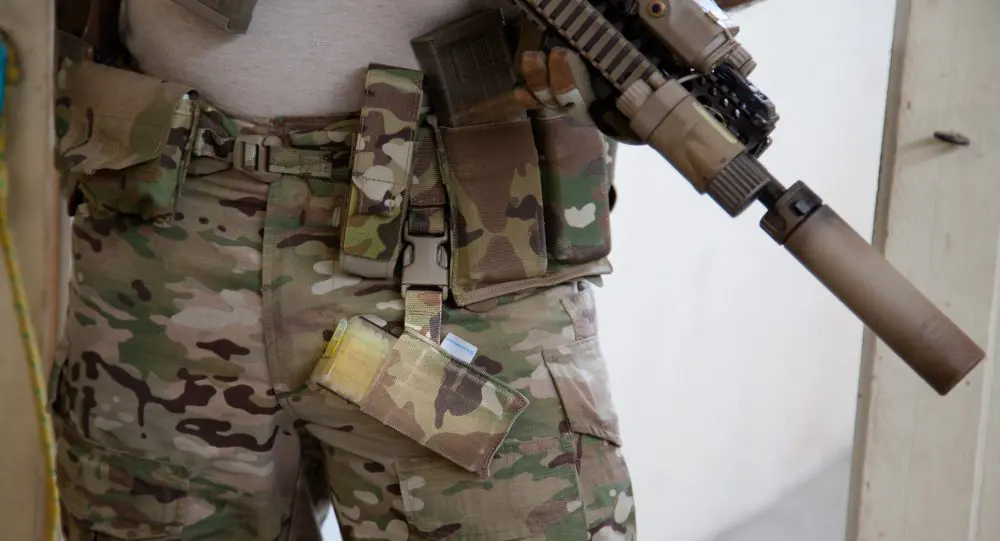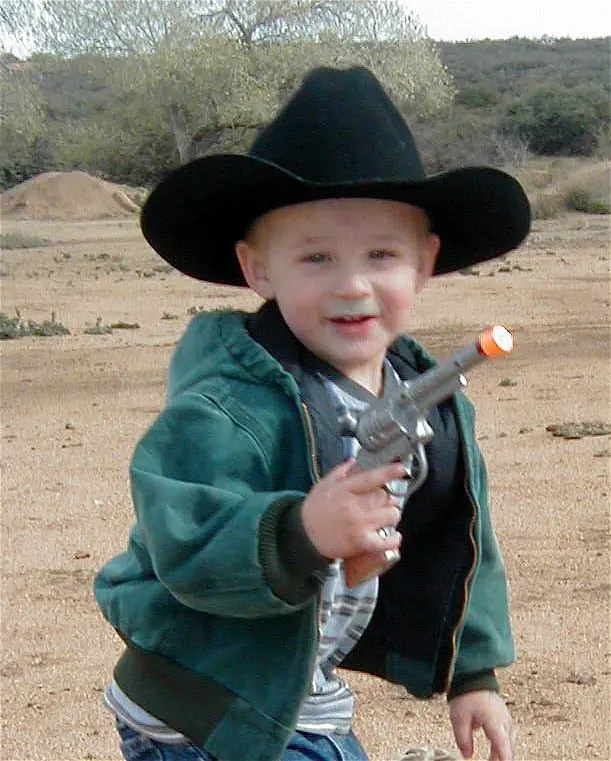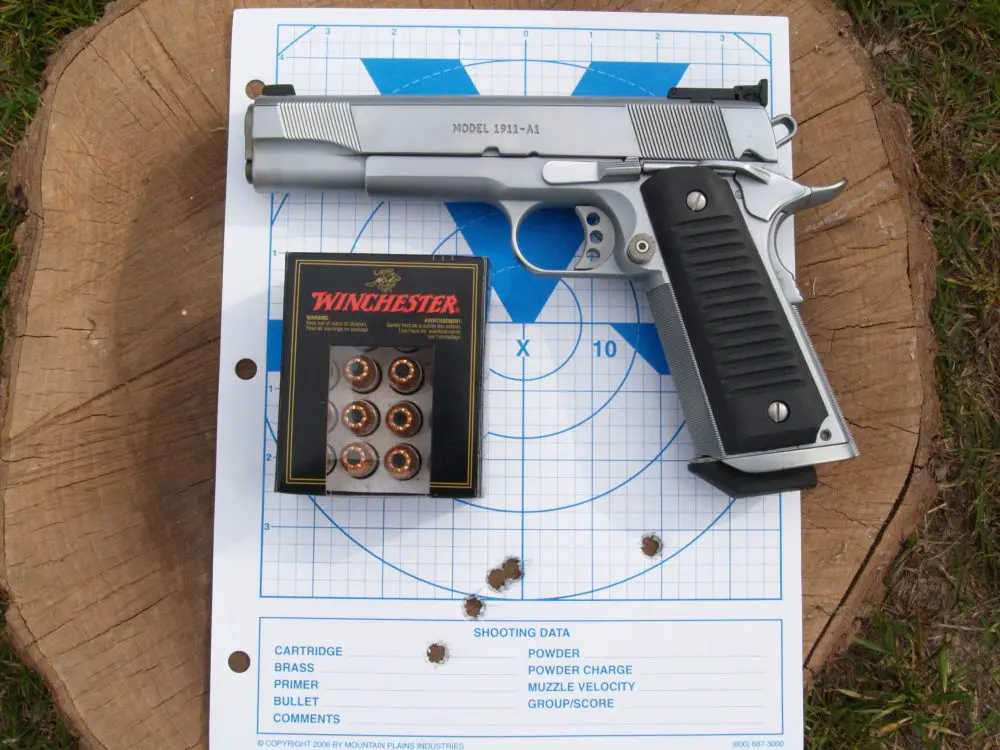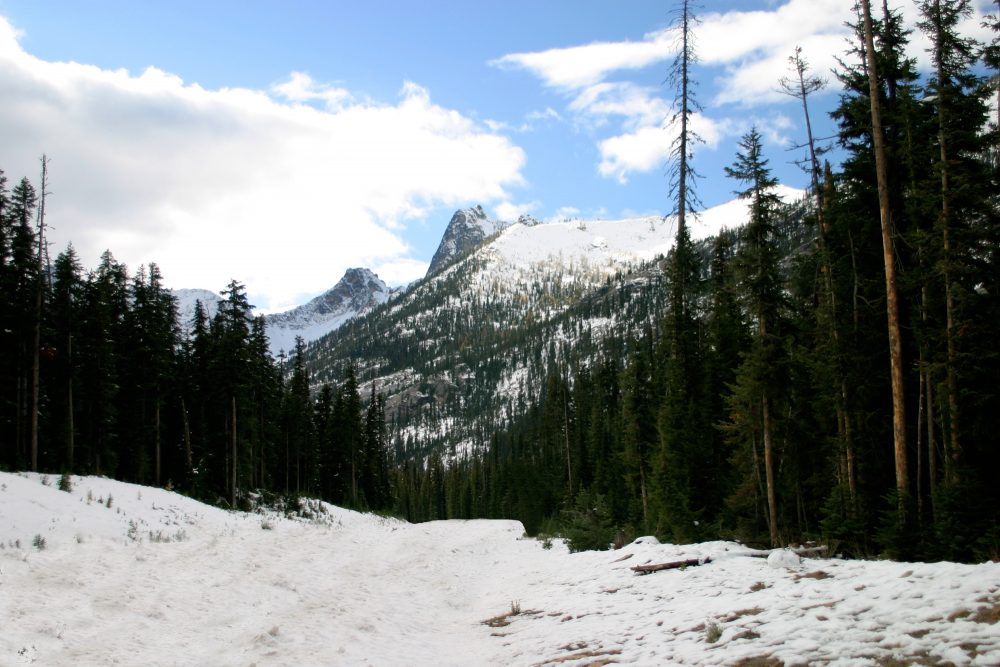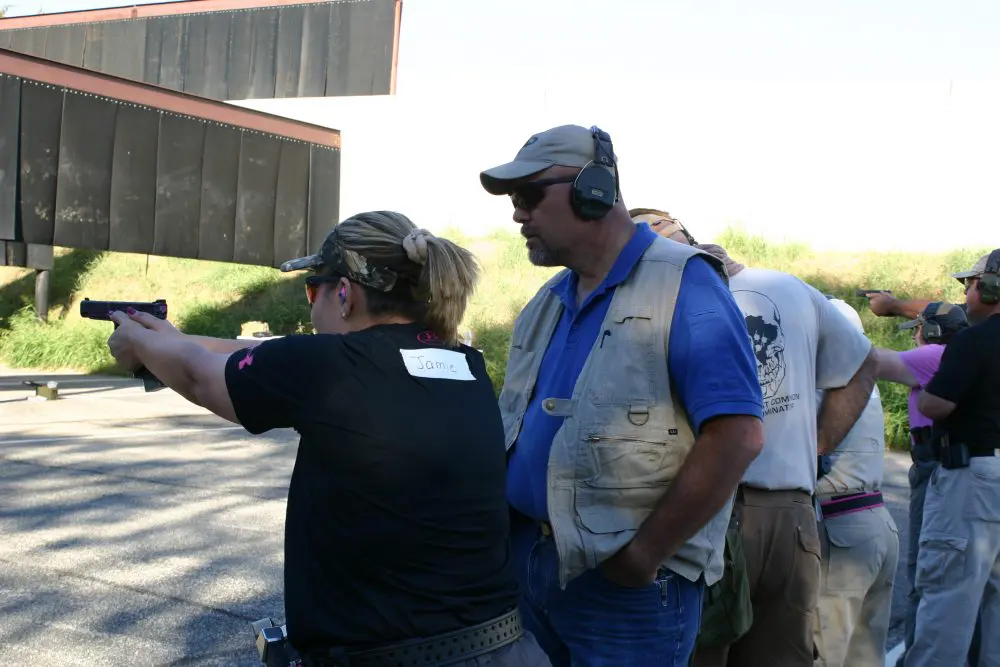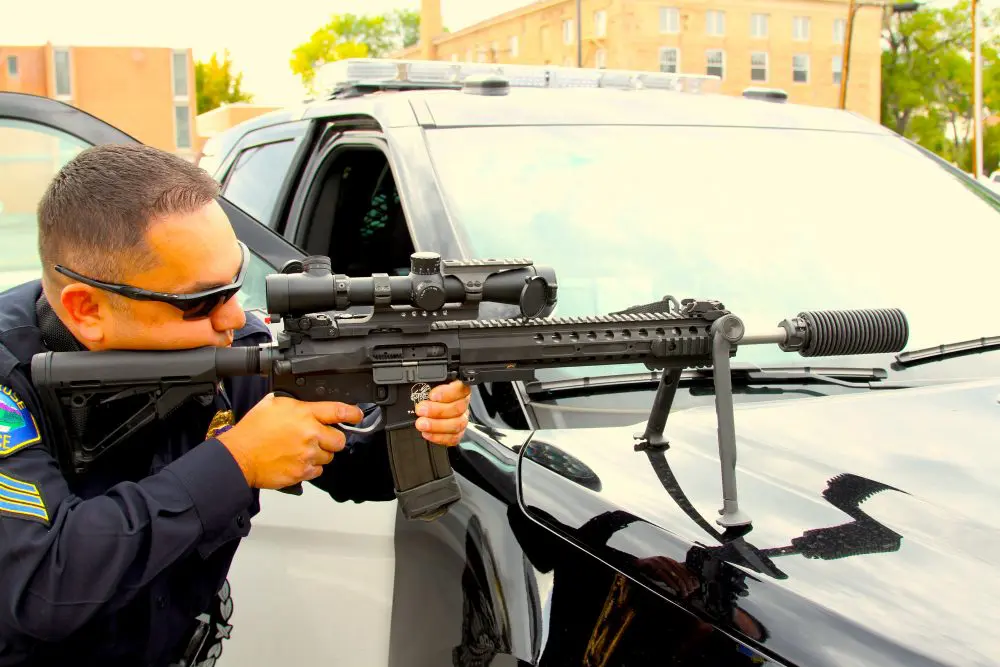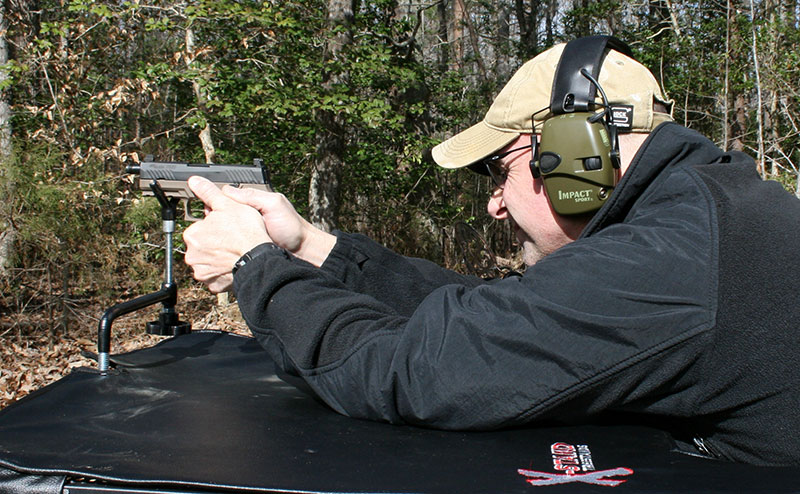
Firearm silencers, suppressors, sound moderators, and cans range from crude improvisations to the low- or no-maintenance advanced metal tubes we have today.
Examples of the former are “spud silencers”(potatoes jammed onto the end of a revolver barrel), plastic bottles and car oil filters screwed onto threaded barrels, as well as tire inner tubes stretched over the entire handgun.
Some, such as the spud, are single use, and all offer varying degrees of a lowered sound signature. Accuracy was questionable or an afterthought, and perhaps even irrelevant, with close-contact “wet” missions.
Table of Contents
ECLECTIC HOUSE
SIG Sauer has a wide range of shooting products that it offers to both professionals and the shooting public. Their catalogs are filled with long and short guns in rimfire and centerfire, conversion kits, holsters and gun bags, blades, shooting apparel, high-performance ammunition, air-powered weapons, and more.
The latest offerings include extremely sophisticated silencers that have been developed by SIG’s newly established Silencer Division. Although their “cans” are standalone items, SIG has groomed one of its highly flexible P320 striker-fired, modular pistols to be its belated quiet handgun for both sport and professional use.
FBI’S QUEST FOR QUIET

During my service, the FBI had a few old World War II .32 ACP Welrods that produced a very subdued 73dB. Maximum effective range was 40 feet. But no one could recall why we had them in our gun vault. When field SWAT started to mature, we acquired several old silenced High Standard .22 rimfire pistols from another agency to quietly shoot out street lights and deflate potential escape vehicle tires during SWAT operations. They were high maintenance and we couldn’t get enough for the field, so we turned to Heckler & Koch and acquired numerous MP5SD integrally suppressed submachine guns (SMG). Each field office had one or two of them.
The SDs actually preceded our acquisition of MP5A3 SMGs. Subsonic Winchester 147-grain ammunition literally dribbled out its vented and stunted barrel, causing agents to question its lethality. Nevertheless, one was used in Atlanta to burn through an AC ventilation grate to neutralize a hostage taker.
The FBI director at the time was not comfortable with the fact that the subject was hit numerous times, but the agent, accompanied by an M1 carbine-armed police officer, had to fire full-automatic to breach the grate and engage the gremlin as quickly as possible with a hail of bullets. When initially hit, the subject appeared to be confused, before he realized what was happening and by that time it was too late.
Another was used against a drug dealer’s attack dog, which still managed to pin an agent against a fence with nine SD rounds in it. The noble animal—doing what it had been trained to do—had to be finally put down with pistol fire.
LOS ANGELES OLYMPICS
If area ambient noise is low and you are listening for a suppressed weapon’s signature, chances are good you will detect it, but you might not be able to pinpoint its origin. But under normal daily urban conditions, it will generally go unnoticed or unidentified.
During standby for the 1984 Los Angeles Olympics, the LAPD SWAT team and FBI HRT ran a joint live-fire training exercise in an abandoned 12-story downtown office building. Surrounding jurisdictions’ police officers volunteered as live hostages and paper aggressor, and no-shoot targets were backed up by bullet traps. The eye- and ear-protected hostages sat on the deck as a group in a clearly marked quarantined section of the room.
The FBI penetrated the building via a tunnel that connected with another building across the street and attacked up to a limit of a designated floor. LAPD used ladders as bridges from an adjacent building’s rooftop to assault from the top down.
The assault was initiated by suppressed weaponry. HRT was running HK P9S pistols with cans attached and HK MP5SDs. LAPD had a WWII, but very effective, .45 ACP De Lisle carbine. The MP5SD and De Lisle took out rooftop sentries blocking LAPD’s final approach, which was followed up during the respective explosive breaches by a combined team of LAPD/HRT snipers neutralizing threats of opportunity from a hide across the street.
I was situated 12 stories below waiting for the suppressed weapons to start the show, and I clearly heard one of them. There was no traffic and the area had been isolated well before the training exercise, save for some homeless men standing in front of a shelter. One asked a perimeter police officer, “What’s the name of this movie? I gotta see this one!”
Sophisticated suppressors continue to augment FBI HRT shoulder weapons for CQB and sniping. Dedicated suppressed handguns have been part of the team’s inventory since the LA Olympics.
NEW BREED OF QUIET
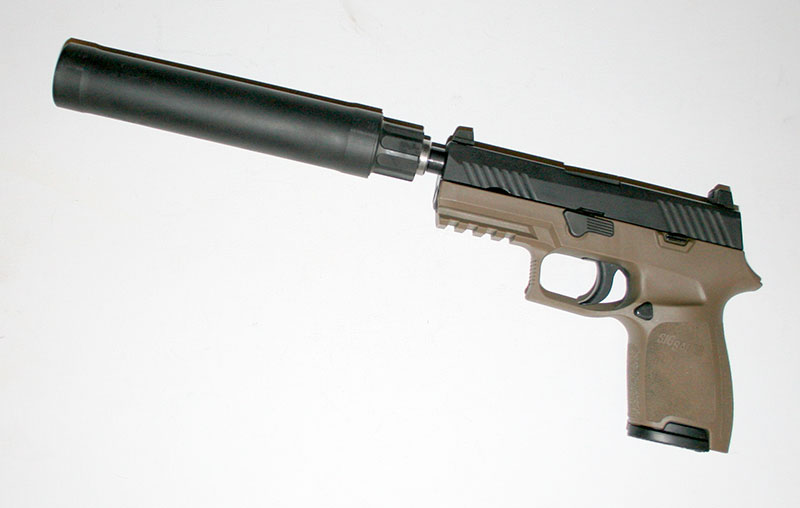
Twenty-first century suppressors are lighter, smaller, and lower maintenance than previous models. Tubes—both oval and rectangular—are made of lighter and stronger materials such as Titanium and stainless steel. The latter is used for the mounts to avoid galling or corrosion between barrel threads and mount. Other metals include aluminum and Inconel 625—an iron-bearing nickel alloy now included among metallurgical choices for suppressor construction.
There has been a virtual explosion in the manufacture of firearm suppressors. Part of this is due to the relaxation of restrictions on silencers at the state level and the pent-up demand by the common shooter/hunter to have the ability to project power quietly. Legislation is in the offing to eliminate the $200 ATF tax stamp and make purchasing these devices as simple as it is to buy a firearm.
SIG SILENCER DIVISION
SIG Sauer offers ten “cans” for rifle and pistol, ranging in calibers from .17-.22 Rimfire to .338 Lapua. Several suppressors accommodate multiple calibers. For example, the SRD45 handles 9mm, .40 S&W, and .45 ACP. I would speculate that .357 SIG could be included, but not subsonic.
Their pedigree can be traced to AAC, which was founded by SIG engineer Kevin Brittingham. These devices have a plethora of innovations, making them leaders of this specialized industry. Single-tube designs in Titanium and stainless steel that exceed or maintain traditional two-tube designs allow for additional internal volume. This design results in exceptional reduction in dBs, very low semi-auto blowback, increased accuracy, and reduced point-of-impact (POI) shift.
Single-tube designs are lighter and quieter, and their internal porting uses the internal volume more efficiently. Uniquely, SIG Sauer has created baffles, so that their cylindrical flanges are the silencer tube and weld them together. Welding makes for a lighter system.
SRD9 SILENCER
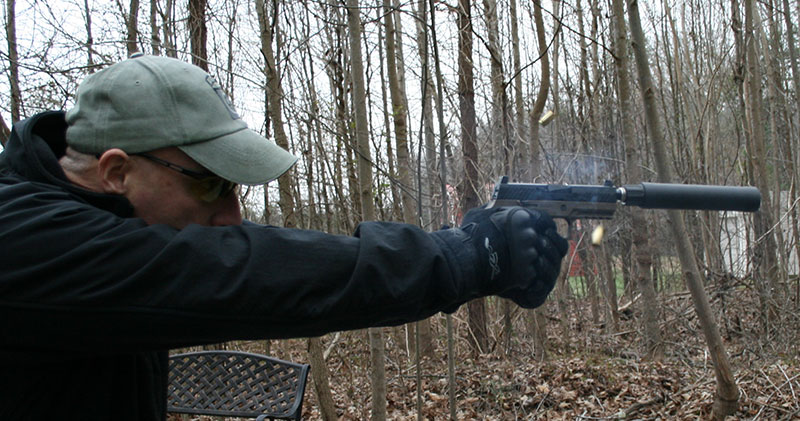
At approximately $700, this 9mm sound moderator can exceed the price of many pistols it might service. Add to that the $200 for the transfer tax, and acquiring this sophisticated device can be a costly matter. But overall it is less expensive than it once was, and I have seen the SRD9 advertised in the low $600s.
The Grade Nine Titanium tube is 1.38 inches in diameter, weighs 14 ounces, and is full-auto rated. Baffles are constructed of 17-4 stainless steel. Pistols with barrels that unlock and tilt during cycling often need the aid of Nielsen devices or recoil boosters to overcome the length and weight of the can on the end of the barrel.
SIG provides two mounts with different thread diameters. Barrel spacers are available for fixed barrels. These are large-volume suppressors, which translate into greater sound reduction and make it easier to hog out accumulated deposits of combustion.
With its high nickel alloy baffles and hardened end caps, the SRD9 is “maintenance free.” But its manual goes to substantial lengths describing maintenance and provides a disassembly/assembly wrench for these procedures.
Unfortunately, the manual does not contain trouble-shooting information or recommendations regarding the reduction of first-round pop and subsequent rounds dB diminution, even though the device is designed to be run wet for maximum sound reduction.
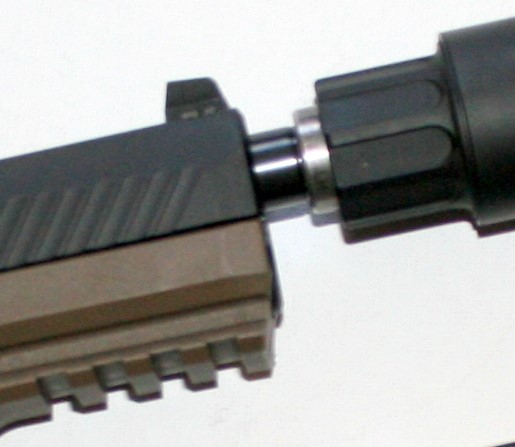
Obviously, muzzle report will increase as the tube’s innards dry up, unless you pause and reintroduce a liquid coolant or special gel via its muzzle. A note of caution: JHP ammunition should not be used when water or another sound-reducing substance has been deposited into the tube. They could expand beyond the baffle’s caliber when encountering water or other liquids and destroy the silencer. Run dry, it makes no difference if FMJ or JHP ammo is fired, but sintered bullets are best left out of the suppressor equation.
With subsonic ammunition, the SRD9 fired dry is rated at 128 to 132db. 9mm, .40 S&W, and .45 ACP emit dB levels of 165. Logarithmically, a 30dB reduction would result in a 1,000 times quieter gun’s report. Although “experts” admonish that no sound moderator is totally silent, the latter term is preferred by SIG, because that’s what it has been called historically and is how the boys and girls at ATF officially reference it.
I wanted to compare the P320 unsuppressed threaded barrel with the suppressed tube attached. It has been my experience with rifle suppressors that there is often a gain in accuracy and velocity. During the 15-yard accuracy phase of evaluation, I noticed a slight tightening of groups with the endcap removed from the barrel. The endcap protects the threads while the silencer is not in use, but when hand tightened, shoots loose after a few rounds have been expended. I had to check it frequently and retighten it.
NOT ONLY HEAVYWEIGHTS NEED APPLY
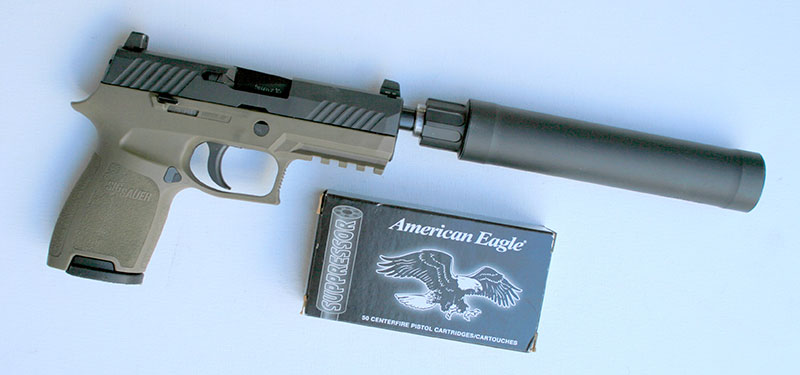
Of the heavy weight rounds fired, (147 to 165 grains), the P320 C and threaded barrel loved the company’s proprietary V-Crown, 147-grain JHP ammunition. American Eagle (AE) 147-grain FMJ Flat Nose and Speer G2 147-grain ran a close second and third respectively. Interestingly, AE also offers a 124-grain subsonic cartridge, which was the lightest bullet used in the evaluation. SIG’s manual does not recommend using bullet weights over 147 grains with the P320 C’s 1:10 twist barrel.
With a great deal of anticipation, I mounted the suppressor to the P320’s threaded barrel. The pistol’s weight shifted forward, but the tube did not feel that heavy nor did it dramatically alter the pistol’s balance. When the SRD9 is affixed to the 26.5-ounce P320 C, total weight jumps to 41.1 ounces. With 16 rounds of 147-grain ammunition on board, weight catapults to 48.9 ounces and the balance shifts rearward. Since the pistol’s barrel length was less than four inches with a corresponding shorter sight radius, we shot from a bench 15 yards from the target. Accuracy at this distance was excellent. The can was super quiet.
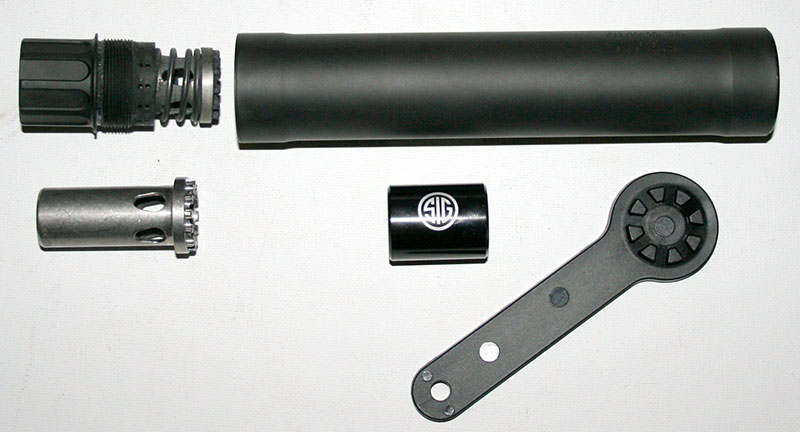
But our initial sortie with suppressor attached was a disaster. In addition to complete loss of unsuppressed accuracy, the pistol would not cycle and had to be manually functioned. SIG customer service advised that P320 C threaded barrels had to be recut, because they were not unlocking properly.
I had had the dedicated upper and threaded barrel for over a year while waiting for ATF Class III approval and was never apprised by SIG of a recall. As an aside, the suppressor worked fine when attached to my P226 pistols.
Fast forward. With the new barrel and SRD9 attached, we picked up where we had halted the evaluation. Groups were tight, but point of impact shifted and the suppressed P320 C now shot low, whereas the unsuppressed pistol shot high. Three rounds for accuracy and velocity evaluations were used to preserve my ammunition supply, which in spite of manufacturer’s generosity was limited.
Almost every brand of subsonic ammunition involved failed to fully cycle the pistol. Numerous failures to eject required us to manually clear the P320. The weather had been cold, with nights dropping to 20 degrees. Before this phase of testing, the ammo had resided in my truck for several days. Cold ammo can lose velocity and may not produce enough pressure to cycle a semiautomatic weapon.
Thinking that the weather might be the culprit, I brought the ammunition indoors to heat up. The next day I returned to the range, but pistol cycling did not improve. Only two of the six brands tested successfully cycled the P320 platform.
Usually +P supersonic will run the suppressor/pistol combo fine, but I had one failure to eject with that combination as well. In all, the rounds that were ejected dribbled out and pooled a couple of feet to my right.
FIRST-ROUND POP
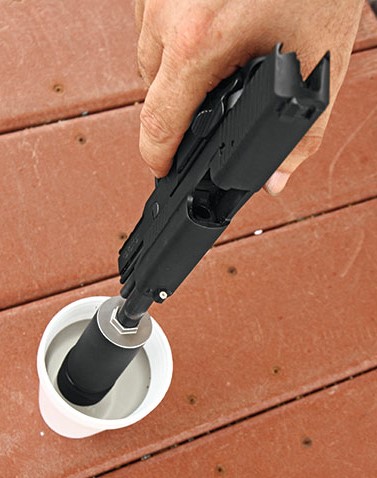
Twenty years ago, Reed Knight demonstrated his suppressors at the FBI Academy. One of the “tricks” he and others in the business discovered was that “first-round pop” could be mitigated by introducing a small amount of water into the suppressor’s body. This not only displaced oxygen, but also cooled the hot gasses and lowered the initial and subsequent rounds’ signatures. I have also been told by military snipers who wanted to preserve their drinking water that they urinated into the tube for the same reason.
With the SRD9, I have used water, Remington Oil Aerosol, and Wire lubrication. The Wire lube was the most effective in augmenting sound reduction. The lube lasts for about 20 rounds.
RETURN FROM HOSPITAL
After a short convalescence at the factory, the P320 C and my dedicated suppressor slide received the Voluntary Upgrades and the SRD9 was examined. It turns out that its piston was compromised by an acute buildup of carbon around it. After cleaning and lubrication of the piston, the suppressor performed properly with five different brands of ammunition at the factory.
Contradicting its low-maintenance advertising, SIG technicians recommend cleaning the SRD9 after each shooting session or after 150 rounds have been expended. I had not put that many rounds through the can and was surprised it needed so much attention. The buildup of crud could be partially attributed to my using Wire lube to mitigate first-round pop. Plain water will be my source of augmented sound reduction in the future.
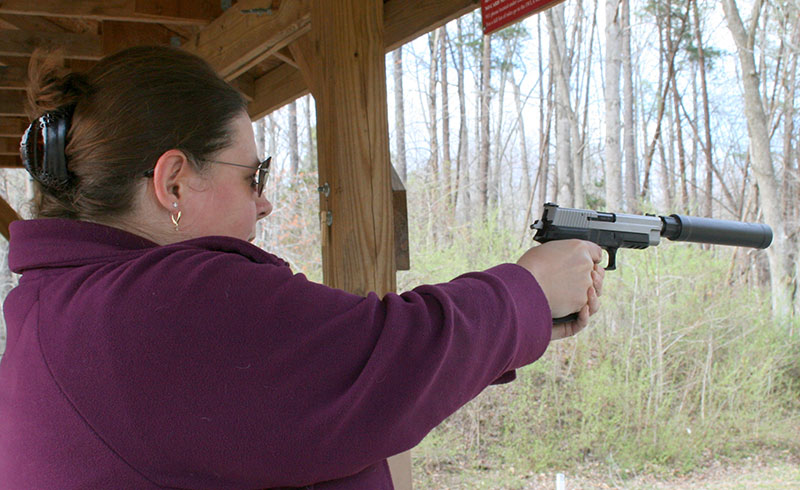
Conversely, my other suppressors are considered low maintenance and continue to save my hearing without, as of yet, a thorough cleaning. Subsequently, the SRD9 performed as promised. POI did not change significantly from point of aim (POA), but hits were low. However, silencer manipulation by rotating the tube in 15-degree increments will merge POI with POA. Others have reported that their offhand accuracy has improved by the elimination of muzzle blast.
CONCLUSIONS
In five of the eight loads fired, the SRD9 produced 62.5% tighter groups. In six of the eight loads fired, the “silencer” achieved 75% higher velocities.
I hope SIG appreciates the product troubleshooting I have been performing. Humor aside, I consider my initial experience with the above system an anomaly, because my past experiences with any SIG product have been excellent.
SOURCES
SIG SAUER, INC.
(603) 610-3000
www.sigsauer.com
SILENCER SHOP
(512) 932-5556
www.silencershop.com
SRD9 SPECIFICATIONS
| MANUFACTURER | SIG Sauer |
| MODEL | SRD9 |
| CALIBER | 9mm Luger |
| WEIGHT | 14 ounces |
| DIAMETER | 1.38 inches |
| OVERALL LENGTH | 7.2 inches |
| ATTACHMENT | Direct thread |
| MATERIAL | G9 Titanium, 17-4 PH stainless steel baffles |
| FINISH | PVD |
| SOUND REDUCTION | 128db dry |
| FULL-AUTO RATED | Yes |
| TOOLS | Disassembly wrench |
| SUGGESTED RETAIL PRICE | $775.00 |
SIG SAUER P320 C PERFORMANCE
| CARTRIDGE | US VELOCITY (feet-per-second) |
US GROUPS (inches) |
S VELOCITY (feet-per-second) |
S GROUPS (inches) |
| American Eagle 124-gr. subsonic | 1,035 | 1.63 | 1,026 | 1.66 |
| American Eagle 147-gr. | 943 | 1.05 | 955.7 | 1.27 |
| Federal 150-gr. | 930.1 | 0.99 | 938.2 | 1.11 |
| Hornady 147-gr. | 973.7 | 1.45 | 1,020 | 0.62 |
| PPU 158-gr. | 908.6 | 0.87 | 892 | 0.55 |
| SIG 147-gr. | 949 | 0.26 | 958 | 0.67 |
| Speer 147-gr. GPHP | 958 | 0.52 | 965.6 | 0.69 |
| Winchester 147-gr. JHP | 1,014 | 0.75 | 1,033 | .54 |
Suppressed (S) / Unsuppressed (US)
Average three-round groups fired from a handheld rest at 15 yards. Average five-round velocities fired through a CED M 2 chronograph with sky screens ten feet from the muzzle. Temperature 40 degrees.

